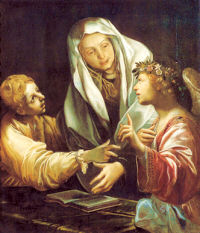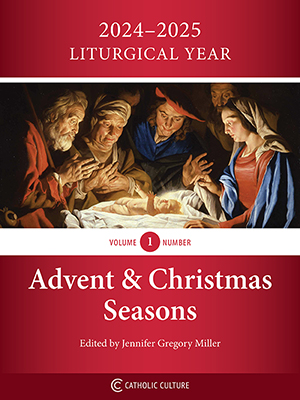Lent: March 9th
Saturday of the Third Week of Lent; Optional Memorial of St. Frances of Rome, Religious
Other Commemorations: Forty Martyrs of Sebaste (RM); St. Dominic Savio (RM)
» Enjoy our Liturgical Seasons series of e-books!
The gifts received by us from God are derived not from ourselves but from the Holy Spirit, and are to be used, in a spirit of humility, in the service of the Church and of our brothers.
The parable of the Pharisee and the Publican is a striking reminder that we have no grounds for self-satisfaction. There are two classes of men, said Pascal: saints, who consider themselves guilty of every fault, and sinners, who do not feel guilty of anything. The former are humble and God will exalt them; the latter are proud and will be humbled by punishment. Going even deeper, St. Irenaeus defined man as "the receptacle of God's gifts."
God is not content with calling on us to observe His commandments; He gives us His Holy Spirit to transform our lives and make them truly Christian. —St. Andrew Daily Missal
The Church celebrates the Optional Memorial of St. Frances of Rome (1384-1440). In the fifteenth century Frances, among the noble ladies of that great city, showed herself an example of what a Christian wife should be. After the death of her husband she retired from the world and lived in a monastery of Oblates that she had founded under the Rule of St. Benedict. God favored her with the visible presence of her guardian angel with whom she conversed familiarly.
The Roman Martyrology commemorates the Forty Holy Martyrs of Sebaste (d. 302), a group of forty soldiers who suffered a martyr's death for their steadfast faith in Christ, by freezing in a lake near Sebaste, in the former Lesser Armenia (now Sivas in central-eastern Turkey).
St. Dominic Savio (1842-1857) is also commemorated today. He was an Italian, adolescent student of Saint John Bosco. He was studying to be a priest when he became ill and died at the age of 14, possibly from pleurisy.
Meditation—Prayer of Confidence in the Merits and Merciful Power of Jesus
The proud who claim to draw their power form themselves, commit the sin of Lucifer, who said: “I will ascend into Heaven…. I will be like the Most High”; like Lucifer they will be overthrown and cast down into the abyss.
But what do we say? That without Christ, we can do nothing, as He has Himself declared. We declare that it is through Jesus, with Jesus, that we can arrive at holiness and enter into Heaven; we say to Christ: “Master, I am poor, miserable, naked, weak, of this I am daily more and more convinced. But I know, too, that Thou art ineffably powerful, great and good; I know that the Father Thou lovest so much hath placed in Thee all the treasures of holiness that men may desire; I know that Thou wilt never reject those who come to Thee. Therefore, whilst adoring Thee in the deepest recesses of my soul, I have full confidence in Thy merits and satisfactions; I know that, altogether miserable as I am, Thou canst, by Thy grace, shower Thy riches upon me, uplift me even to the Divine, that I may be made like unto Thee and may share in Thy Divine Beatitude!”
—Dom Columba Marmion, Christ the Ideal of the Monk
St. Frances of Rome
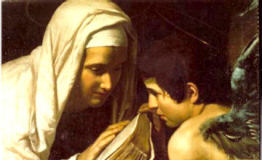 St. Frances of Rome (1384-1440) founded the institute known as the "Oblati di Tor de Specchi" in the Holy City. She was a wealthy patrician and after her husband died, she gave up all her wealth to live a life of abject poverty. Her special privilege from heaven was familiar conversation with her guardian angel. Reading the life of St. Frances, one gains the impression that she moved and lived in the spiritual world more than on earth; in fact, that which gives her life its unique character is her intimate relationship with the blessed world of holy spirits.
St. Frances of Rome (1384-1440) founded the institute known as the "Oblati di Tor de Specchi" in the Holy City. She was a wealthy patrician and after her husband died, she gave up all her wealth to live a life of abject poverty. Her special privilege from heaven was familiar conversation with her guardian angel. Reading the life of St. Frances, one gains the impression that she moved and lived in the spiritual world more than on earth; in fact, that which gives her life its unique character is her intimate relationship with the blessed world of holy spirits.
During the three periods of her life, three angels of different rank accompanied her, ready to protect her soul against any onslaught of hell and to lead her step by step to spiritual perfection. Day and night the saint saw her angel busy at a mysterious task. With three little golden spindles he unceasingly spun golden threads, strung them around his neck, and diligently wound them into balls. A half year before her death he changed his work. Instead of spinning more golden thread, he began to weave three carpets of varying size with the golden thread he had spun. These carpets symbolized her lifework as virgin, mother, and religious.
Shortly before her death, she noticed how the angel was hurrying his work, and his face was unusually fresh and happy. At the very moment when the last carpet had reached its required length, her soul departed into eternal bliss.
—Excerpted from The Church's Year of Grace, Pius Parsch
Patronage: against plague; automobile drivers, motorists (proclaimed by Pope Pius XII on 9 September 1951); automobilists; aviators; cab drivers, taxi drivers; death of children; lay people; motorcyclists; people ridiculed for their piety; pilots; Roman housewives; widows; women; Rome, Italy
Symbols and Representation: often depicted as a woman habited in black with a white veil, accompanied by her guardian angel, and sometimes carrying a basket of food; Nun with her guardian angel dressed as a deacon; Monstrance and arrow; book; angel with a branch of oranges; receiving the veil from the Christ Child in the arms of the Blessed Virgin
Highlights and Things to Do:
- Read more about St. Frances of Rome:
- St. Frances of Rome's remains are located at Santa Francesca Romana. Her skeleton is clothed in the habit of the Oblates of St. Frances of Rome.
- In 1925, Pope Pius XI assigned St. Frances of Rome the patronage for protection of motorists because an angel used to light the road before her with a lantern when she traveled for her safety. Invoke St. Frances' protection as you are getting in your car to drive somewhere today.
- Find out more about the Oblates of St. Frances of Rome or see the main site, in Italian.
- St. Frances was certain that she had a vocation to the religious life from the age of eleven. However, her father forced her to marry, and so she instead joyfully loved and served her husband until his death enabled her to enter the religious life when she was fifty-two years old. Even when you may have certainty that God is calling you to walk a certain path, His timing may be different from your own. Reflect on your own vocation: regardless of any doubts you may have, or seemingly unfulfilled desires to do more for God, abandon yourself to His will of the present moment, and joyfully focus on fulfilling the small duties which your vocation asks of you. Read about sanctification through the present moment in Rev. Jean-Pierre de Caussade's excellent little work, Abandonment to Divine Providence.
The Forty Holy Martyrs of Sebaste or Armenia
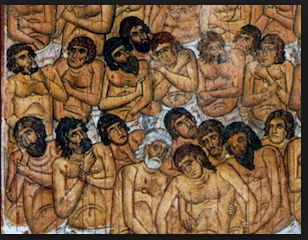 The Forty Martyrs were soldiers quartered at Sebaste in Armenia, about the year 320. When their legion was ordered to offer sacrifice to idols, they refused to betray the faith of their baptism, and replied to all persuasive efforts, “We are Christians!” When neither cajolings or threats could change them, after several days of imprisonment they were chained together and taken to the site of execution. It was a cruel winter, and they were condemned to lie without clothing on the icy surface of a pond in the open air until they froze to death.
The Forty Martyrs were soldiers quartered at Sebaste in Armenia, about the year 320. When their legion was ordered to offer sacrifice to idols, they refused to betray the faith of their baptism, and replied to all persuasive efforts, “We are Christians!” When neither cajolings or threats could change them, after several days of imprisonment they were chained together and taken to the site of execution. It was a cruel winter, and they were condemned to lie without clothing on the icy surface of a pond in the open air until they froze to death.
The forty, not merely undismayed but filled with joy at the prospect of suffering for Jesus Christ, said: “No doubt it is difficult to support so acute a cold, but it will be agreeable to go to paradise by this route; the torment is of short duration, and the glory will be eternal. This cruel night will win for us an eternity of delights. Lord, forty of us are entering combat; grant that we may be forty to receive the crown!”
There were warm baths close by, ready for any among them who would deny Christ. One of the confessors lost heart, renounced his faith, and went to cast himself into the basin of warm water prepared for that intention. But the sudden change in temperature suffocated him and he expired, losing at once both temporal and eternal life. The still living martyrs were fortified in their resolution, beholding this scene.
Then the ice was suddenly flooded with a bright light; one of the soldiers guarding the men, nearly blinded by the light, raised his eyes and saw Angels descend with forty crowns which they held in the air over the martyrs’ heads; but the fortieth one remained without a destination. The sentry was inspired to confess Christ, saying: “That crown will be for me!” Abandoning his coat and clothing, he went to replace the unfortunate apostate on the ice, crying out: “I am a Christian!” And the number of forty was again complete. They remained steadfast while their limbs grew stiff and frozen, and died one by one.
Among the forty there was a young soldier named Meliton who held out longest against the cold, and when the officers came to cart away the dead bodies they found him still breathing. They were moved with pity, and wanted to leave him alive, hoping he would still change his mind. But his mother stood by, and this valiant woman could not bear to see her son separated from the band of martyrs. She exhorted him to persevere, and lifted his frozen body into the cart. He was just able to make a sign of recognition, and was borne away, to be thrown into the flames with the dead bodies of his brethren. Their bones were cast into the river, but they floated and were gathered up by the faithful.
—Excerpted from Little Pictorial Lives of the Saints, a compilation based on Butler’s Lives of the Saints and other sources by John Gilmary Shea (Benziger Brothers: New York, 1894); Vie des Saints pour tous les jours de l’année, by Abbé L. Jaud (Mame: Tours, 1950)
Patronage: Persecuted Christians
Symbols and Representation: Forty men; crown of martyrdom; martyr's palm
Highlights and Things to Do:
- Read more about the Forty Holy Martyrs:
- Read St. Basil's Homily on their festival.
- The martyrs are honored also in Eastern Orthodoxy, Oriental Orthodoxy, the Lutheran Church and the Anglican Church.
St. Dominic Savio
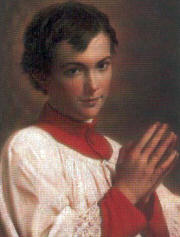 Here was a boy-saint who died at the age of fifteen, was one of the great hopes of St. John Bosco for the future of his congregation, and was canonized in 1954.
Here was a boy-saint who died at the age of fifteen, was one of the great hopes of St. John Bosco for the future of his congregation, and was canonized in 1954.
He was one of ten children of Carlo and Birgitta Savio. Carlo was a blacksmith and Birgitta was a seamstress. When Don Bosco was looking for young men to train as priests for his Salesian Order, his parish priest suggested Dominic Savio. Dominic became more than a credit to Don Bosco's school—he single-handedly organized those who were to be the nucleus of Don Bosco's order.
St. Dominic Savio was twelve when he met Don Bosco and organized a group of boys into the Company of the Immaculate Conception. Besides its religious purpose, the boys swept and took care of the school and looked after the boys that no one seemed to pay any attention to. When, in 1859, Don Bosco chose the young men to be the first members of his congregation, all of them had been members of Dominic's Company.
For all that, Dominic was a normal, high-spirited boy who sometimes got into trouble with his teachers because he would often break out laughing. However, he was generally well disciplined and gradually gained the respect of the tougher boys in Don Bosco's school.
In other circumstances, Dominic might have become a little self-righteous snob, but Don Bosco showed him the heroism of the ordinary and the sanctity of common sense. "Religion must be about us as the air we breathe," Don Bosco would say, and Dominic Savio wore holiness like the clothes on his back.
He called his long hours of prayer "his distractions." In 1857, at the age of fifteen, he caught tuberculosis and was sent home to recover. On the evening of March 9, he asked his father to say the prayers for the dying. His face lit up with intense joy and he said to his father: "I am seeing most wonderful things!" These were his last words.
—Excerpted from The One Year Book of Saints by Rev. Clifford Stevens
Patronage: Boys; children's choirs; choir boys; choirs; falsely accused people; juvenile delinquents; Pueri Cantors.
Highlights and Things to Do:
- Read more about St. Dominic:
- We learned about St. Dominic from St. John Bosco's writings, which you can read online.
- Learn more about the Salesians and Salesian saints.
- Dominic is buried at Basilica di Maria Ausiliatrice or The Basilica of Our Lady Help of Christians in Turin, Italy, with St. John Bosco body nearby.
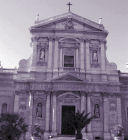
Saturday of the Third Week of Lent
Station with Santa Susanna (St. Susan):
The Station is in the church of St. Susanna, virgin and martyr of Rome. The first Christian place of worship was built here in the 4th century. It was probably the titulus of Pope Caius (283-296). Caius was St. Susanna's uncle, and tradition claims that the church stands on the site of her martyrdom. The church is now the national parish of the United States since 1922.
As of 2019, there is a temporary closure. Currently the substitute Station Church is S. Maria della Vittoria (St. Mary of Victory).
For more on Santa Susanna, see:
For more on S. Maria della Vittoria, see:
For further information on the Station Churches, see The Stational Church.


